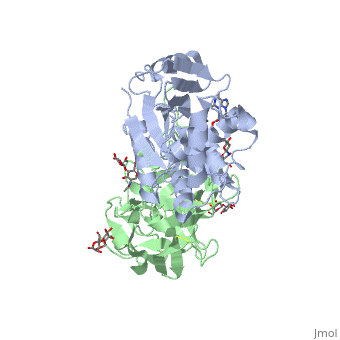Ricin: Structure and function
From Proteopedia
(Undo revision 3551061 by Ajla Pandzic (Talk)) |
|||
| Line 1: | Line 1: | ||
| - | + | ==Ricin== | |
<StructureSection load='3rtj' size='340' side='right' caption='Caption for this structure' scene=''> | <StructureSection load='3rtj' size='340' side='right' caption='Caption for this structure' scene=''> | ||
Found inside of the seeds of the castor oil plant and in castor beans, the cytotoxin, Ricin, is known to be one of Earth's most toxic proteins. Ricin was officially discovered in the year 1888 during the investigation of castor seed toxicity, which had been a mystery to scientists since their observations of its effects in the late nineteenth century. German scientist, Peter Hermann Stillmark, was able to extract this compound from the castor seed and purify it into the structure we see today. Originally thought to be used in aiding cancer patients, its highly toxic nature to humans deemed it too dangerous to use in a medical setting. Doctors and scientists have even worked together to pick apart the protein and use each chain in cancer therapy separately. On the other hand, it’s toxicity attracted the attention of criminals, military, and terrorists who came up with the idea of using it as a weapon in bio-terroristic attacks. <ref>DOI 10.1002/ijch.201300024</ref> or to the article describing Jmol <ref>PMID:21638687</ref> to the rescue. | Found inside of the seeds of the castor oil plant and in castor beans, the cytotoxin, Ricin, is known to be one of Earth's most toxic proteins. Ricin was officially discovered in the year 1888 during the investigation of castor seed toxicity, which had been a mystery to scientists since their observations of its effects in the late nineteenth century. German scientist, Peter Hermann Stillmark, was able to extract this compound from the castor seed and purify it into the structure we see today. Originally thought to be used in aiding cancer patients, its highly toxic nature to humans deemed it too dangerous to use in a medical setting. Doctors and scientists have even worked together to pick apart the protein and use each chain in cancer therapy separately. On the other hand, it’s toxicity attracted the attention of criminals, military, and terrorists who came up with the idea of using it as a weapon in bio-terroristic attacks. <ref>DOI 10.1002/ijch.201300024</ref> or to the article describing Jmol <ref>PMID:21638687</ref> to the rescue. | ||
| Line 12: | Line 12: | ||
== Ricin Poisoning: Treatment == | == Ricin Poisoning: Treatment == | ||
| - | Ricin’s effect on an organism's body can happen so suddenly and severely that the treatment of ricin poisoning is very variable. Scientists and doctors both recommend that those who may have consistent exposure to ricin and maybe at high risk of being poisoned receive vaccinations to prevent ricin from being able to come in contact with internal cells. It is also highly recommended that worksites that produce castor oil and have high levels of ricin circulating throughout solutions go through very extensive decontamination processes. | ||
| - | If an individual does become poisoned, it is important that their water and blood levels are being monitored and maintained as they are given anti-ricin antibodies to protect the cells. This can extend survival time and even help the organism to fight off the ricin completely. | ||
This is a sample scene created with SAT to <scene name="/12/3456/Sample/1">color</scene> by Group, and another to make <scene name="/12/3456/Sample/2">a transparent representation</scene> of the protein. You can make your own scenes on SAT starting from scratch or loading and editing one of these sample scenes. | This is a sample scene created with SAT to <scene name="/12/3456/Sample/1">color</scene> by Group, and another to make <scene name="/12/3456/Sample/2">a transparent representation</scene> of the protein. You can make your own scenes on SAT starting from scratch or loading and editing one of these sample scenes. | ||
Revision as of 17:47, 26 April 2022
Ricin
| |||||||||||
References
Audi J, Belson M, Patel M, Schier J, Osterloh J. Ricin Poisoning: A Comprehensive Review. JAMA. 2005;294(18):2342–2351. doi:10.1001/jama.294.18.2342
Etimad, L., Moshiri, M., & Hamid, F. (2019, June 6). Ricin: An ancient story for a timeless plant toxin. RBMB. Retrieved April 23, 2022, from https://www.ncbi.nlm.nih.gov/pmc/articles/PMC6628454/#sec2-toxins-11-00324title
Gal, Y., Mazor, O., Falach, R., Sapoznikov, A., Kronman, C., & Sabo, T. (2017). Treatments for Pulmonary Ricin Intoxication: Current Aspects and Future Prospects. Toxins, 9(10). https://doi-org.proxy.library.maryville.edu/10.3390/toxins910031
Tumer, N. E. (2019). Introduction to the Toxins Special Issue “Ricin Toxins.” Toxins, 12(1). https://doi-org.proxy.library.maryville.edu/10.3390/toxins12010013/

